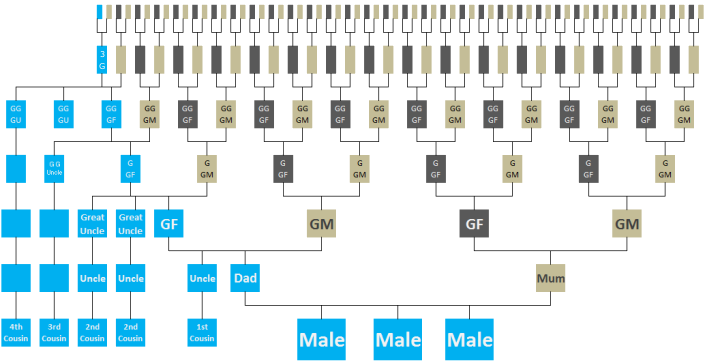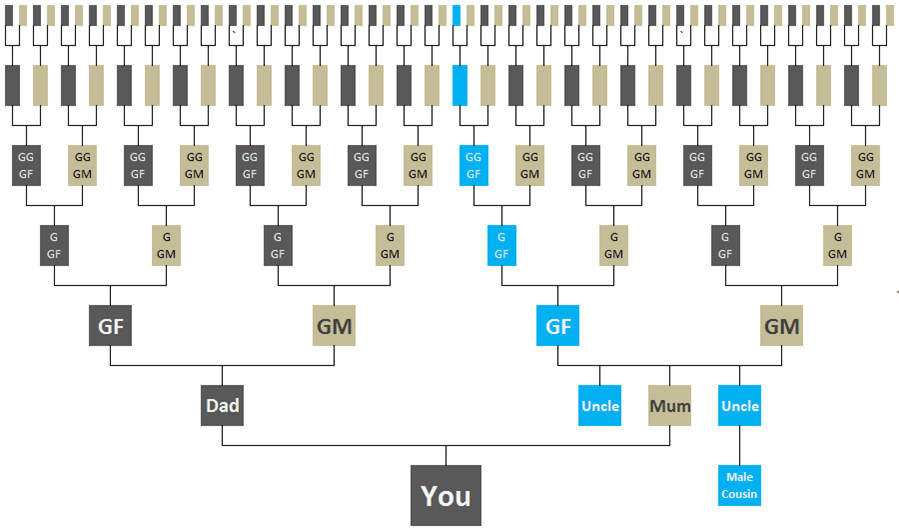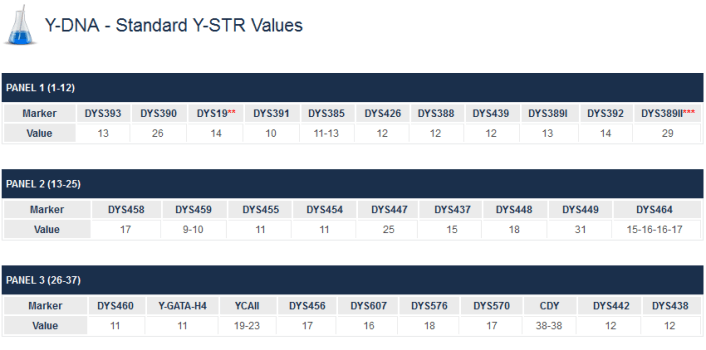All males inherit Y-chromosomes from their father – through his father, his father, his father, etc – represented by the direct paternal line as per the blue boxes on the chart below.
Only males have Y-chromosomes, so only males can take a Y-DNA test.

If a male has an exact match with another male who has tested, it indicates that they descend from the same male somewhere back in time – but it can’t necessarily tell you where and when, as the Y-DNA can remain unchanged for hundreds of years.
Occasional (harmless) mutations can help define particular branches, as once a mutation occurs in a male’s Y-DNA, it is passed down subsequent generations on that line.
The pedigree chart below shows (in blue) males who could potentially share the same Y-DNA – providing there are no NPEs (non-paternal events, such as illegitimacies, adoptions etc).

A male could potentially share a Y-DNA match with any direct male descendant from any direct male in the pedigree, going back many hundreds of years, not just the generations shown in this chart.
Females can test a male relative (eg. father, brother, uncle, cousin) to determine their paternal ancestry.
You are not restricted to testing the Y-DNA of your own paternal line. If you can find a willing male relative from any other surname/paternal line in your tree (eg. your mother’s paternal line), you can test his Y-DNA to investigate that line genetically too.
In the chart below, for example, you could test a maternal uncle or cousin to determine the Y-DNA of your maternal grandfather’s paternal line. Barring NPEs, you just need a male that shares the surname that you want to test.

Y-DNA STR testing examines a number of known markers (locations) on the Y-chromosome, and counts the number of times allele patterns are repeated at that location (STR=Short Tandem Repeats). A numerical result is given for the number of repeats at each marker.
Testing is available at different levels – 37, 67 or 111 markers. The higher level tests will give a more detailed result, ie. more points to compare between testers.
The specific combination of resulting values will determine the Y-DNA haplogroup – which denotes the broad population group those paternal ancestors belonged to, and the position/branch on the Y-haplotree.
A standard Y-DNA 37 marker test will produce panels of values, a sample of which is below:

The sample Y-STR results above are for 37 markers, and predict a common Y-DNA haplogroup of R-M269.
These marker values can be used in surname and geographical projects to compare values between men with the same surnames and men from the same geographical regions.
Because Y-DNA generally follows the surname line, testers can join a FTDNA surname project to compare origins of other men with the same surname.
Y-DNA generally remains unchanged, but occasional mutations (harmless) can help define particular branches, as any such mutations will continue to be passed down the successive direct male line.
Y-DNA testing can be useful for:
Refer to Family Tree DNA’s information pages on Y-DNA tests and Y-DNA Basics.
View FTDNA’s interactive Y-DNA probability chart below, which estimates the number of generations to the common ancestor at different testing levels.
Y-DNA tests with matching and surname projects are only available from Family Tree DNA.
Experts may be interested in the Big Y-700 test.
Also read about mtDNA testing – the direct maternal/female line, and atDNA testing – to find matches on all ancestral lines.